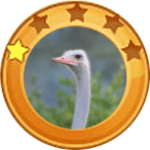- Home
- Shop
- Forest Series
- Grassland Series
- Desert Series
- Contact
- Home
- Shop
- Forest Series
- Grassland Series
- Desert Series
- Contact

Ostrich Series





BEST GIFTS FOR KIDS
The 12V electric ride-on motorcycle with hyper-realistic and nice-looking appearance is suitable for kids from 37 to 95 months. With a push-start button, high and low speed options, the toy motorcycle can be easily driven forward or reverse by your little adventurer, providing the best driving experience to your kid.
SAFETY DESIGN
The 3-wheel design of this ride-on motorcycle toy makes it easy for your child to keep balance. Soft-starting technology ensures the toy car launches and barks slowly so as not to scare your kid from abrupt operation.
GREAT POWER
Our ride on motorcycle for kids is great power due to 12V motors. The ride-on toy can conquer any terrain like grass, dirt, driveways, sidewalks, sand, etc. Long battery makes sure you child can enjoy 50-60 minutes per charge!


CHARACTERISTICS
The Chipmunk is a member of the family Mammalia, Rodentia and Sciuridae. It is also known as the Striped Squirrel, the Timber Tiger and the Mini-bear. The body length among most Chipmunks ranges from 5.5 to 6.3 inches and the tail length is 5 Inches. Chipmunks typically weigh about 0.02 pounds and live about 5 to 10 years. They have small but prominent ears which face forwards, and small eyes on the sides of their heads. Most wild Chipmunks are lively.


Lorem ipsum dolor sit amet, consectetur adipiscing elit. Ut elit tellus, luctus nec ullamcorper mattis, pulvinar dapibus leo.


CHARACTERISTICS

RANGE AND HABITAT

DIET

BEHAVIOR
Habits and Lifestyle
The Somali Ostrich is differentiated ecologically from the common ostrich, with which there is some range overlap, by preferring bushier, more thickly vegetated areas, where it feeds largely by browsing, whereas the common ostrich is mainly a grazer on open savanna. Male ostriches in the wild, or in large domestic flocks, are often seen leading around a small group of females.Mating Habits
Ostrich males are not monogamous during breeding. The male performs elaborate dancing displays, during the mating season, trying to attract the female birds to mate with him. Mating season for ostriches takes place from April to September, with the chicks hatching during the months of October through December.
The Chipmunk is a member of the family Mammalia, Rodentia and Sciuridae. It is also known as the Striped Squirrel, the Timber Tiger and the Mini-bear. The body length among most Chipmunks ranges from 5.5 to 6.3 inches and the tail length is 5 inches. Chipmunks typically weigh about 0.02 pounds and live about 5 to 10 years. They have small but prominent ears which face forwards, small eyes on the sides of their heads. Most wild Chipmunks are lively.
The Red Squirrel, a member of the Sciuridae, is an arboreal, omnivorous rodent often referred to as a Forest Seeder and folklore as the Devil King Squirrel.
The Arizona Gray Squirrel, also known as the American Gray Squirrel, is a member of the family Rodentia and Sciuridae. It is small in size, with gray fur and a belly between white and cream. It has long ears, no tufts of fur and a fluffy tail edged in white. The body is about 16-20 inches long and weighs up to 1.4 pounds.
The Rock Squirrel, also known as Sao Maozi or Stone Mouse, belongs to the rodent and is a species in the family Sciuridae. The most common natural predators of the Rock Squirrel include bobcats, owls, eagles and snakes. Though the Rock Squirrel is cute, alert, and courageous, it is still considered a pest due to its habit of destroying crops.
The Abert’s Squirrel is a member of the genus Sciurus with a body length of 18-22.8 inches, a tail length of 7.5-9.8 inches and a weight of 2.2 pounds, and can live up to 10 years in the wild. Its most distinctive feature is tassels of fur about 0.8-1.2 inches long at the tip of its ears, which looks very interesting. In addition, it is alert and agile.

Digital Safari: How Fast Can Ostriches Run?



Follow Us: